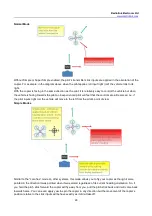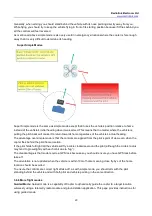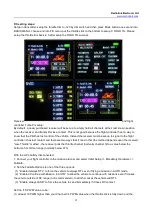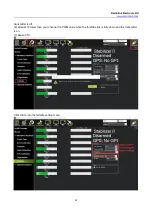
Radiolink Electronic Ltd
42
2. Plug in your LiPo battery. The red and blue lights should flash for a few seconds as the gyros are
calibrated (do not move the copter)
3. The pre-arm checks will run automatically and if any problems are found a Turbo Pix will double blink the
red arming light, on a Pixhawk the RGB led will blink yellow.
4. Check that your flight mode switch is set to Stabilize, ACRO, AltHold.
5. Press the safety button until the light goes solid.
6. If you are planning on using the autopilot (i.e. Loiter, RTL, Drift, Auto or Guided modes) you should wait for
30 seconds after the GPS has gotten 3d lock. This will give the GPS position time to settle. On a Turbo Pix
the RGB LED will blink green.
7. Arm the motors by holding the throttle down, and rudder right for 5 seconds. It takes approximately 5
seconds the first time the copter is armed as it re-initializes the gyros and barometer. Do not hold the rudder
right for too long (>15 seconds) or you will begin the AutoTrim feature.
8. Once armed, the red arming light should go always-on and the propellers will begin to spin.
9. Raise the throttle to take-off.
If you leave the throttle at minimum for 15 seconds while in any of the above modes the motors will
automatically disarm.
It means the drone have failed to disarmed when you heard a long sound like D~~~~.
You can connect the Turbo Pix to computer and check the reason.
RC failures (i.e. transmitter/receiver failures):
RC not calibrated
: the radio calibration has not been performed. RC3_MIN and RC3_MAX must have been
changed from their default values (1100 and 1900), and for channels 1 to 4, MIN value must be 1300 or less,
and MAX value 1700 or more.
Barometer failures:
Baro not healthy
: the barometer sensor is reporting that it is unhealthy which is normally a sign of a
hardware failure.
Alt disparity
: the barometer altitude disagrees with the inertial navigation (i.e. Baro + Accelerometer) altitude
estimate by more than 2 meters. This message is normally short-lived and can occur when the flight
controller is first plugged in or if it receives a hard jolt (i.e. dropped suddenly). If it does not clear the
accelerometers may need to be calibrated or there may be a barometer hardware issue.
Compass failures:
Compass not healthy
: the compass sensor is reporting that it is unhealthy which is a sign of a hardware
failure.
Compass not calibrated
: the compass(es) has not been calibrated. the COMPASS_OFS_X, Y, Z
parameters are zero or the number or type of compasses connected has been changed since the last
compass calibration was performed.
Compass offsets too high
: the primary compass’s offsets length (i.e. sqrt(x^2+y^2+z^2)) are larger than
500. This can be caused by metal objects being placed too close to the compass. If only an internal compass
is being used (not recommended), it may simply be the metal in the board that is causing the large offsets
and this may not actually be a problem in which case you may wish to disable the compass check.
Check mag field
: the sensed magnetic field in the area is 35% higher or lower than the expected value. The
expected length is 530 so it’s > 874 or < 185. Magnetic field strength varies around the world but these wide
limits mean it’s more likely the compass calibration has not calculated good offsets and should be repeated.













































